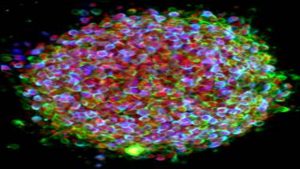 Stem cells — they work almost like magic, generating new tissue, secreting mysterious “factors” that cause other cells to regenerate, replacing cancer-ridden bone marrow and performing other miracles.
Stem cells — they work almost like magic, generating new tissue, secreting mysterious “factors” that cause other cells to regenerate, replacing cancer-ridden bone marrow and performing other miracles.
Little wonder, then, that clinics offering treatments using these cells are popping up all over the place.A new study published Thursday finds hundreds of clinics advertising often unproved stem cell treatments for serious diseases such as muscular dystrophy, for autism and for cosmetic procedures such as face lifts and breast enlargements.
Although they don’t accuse any of them of committing fraud, the researchers say they worry at least some of the clinics are exploiting a lack of regulation and a lack of education about stem cells. They found them just as patients likely would: using the internet.
“We found 351 U.S. businesses engaged in direct-to-consumer marketing of stem cell interventions offered at 570 clinics,” Leigh Turner of the University of Minnesota’s Center for Bioethics and Paul Knoepfler, a pediatric stem cell expert at the University of California Davis who also blogs about stem cell regulation, write in the journal Cell Stem Cell.
Some appear to take advantage of the confusing nature of stem cells — a term that refers to a wide variety of different cells with hugely different properties. Stem cells can refer to pluripotent stem cells, which make up days-old embryos and which give rise to all the tissues in the body and, indeed, to a whole, living organism.
Adult stem cells are found throughout the body — in blood, fat and other tissues. Stem cells are found in a newborn’s umbilical cord and in the placenta.They can refer to semi-matured cells, which have already begun to form a certain tissue type, such as bone and muscle, fat or nerves. And they can refer to the cells made in the bone marrow that give rise to blood and immune system cells.
There are also lab-made cells called induced pluripotent stem cells or iPS cells, which have been “tricked” into going back to an embryonic-like state so that scientists can then turn them into a different cell type.
Cancer patients are sometimes treated with bone marrow stem cell transplants, either from other donors —allogeneic stem cells — or from the patient’s own body in what’s called an autologous transplant.
To manipulate these cells and use them as treatments requires specialized knowledge and the field is still very much experimental. Yet clinics are popping up across the country and across the world, and even cosmetics claim to deliver “stem cells” right to the skin.
To address the urgent need for better information concerning the U.S. marketplace for such businesses, we used Internet key word searches, text mining, and content analysis of company websites to investigate and analyze this arena,” Turner and Knoepfler wrote.
“Many stem cell companies employ multiple physicians and advertise interventions available at numerous clinics.”They found stem cell hotspots in California, Florida, Texas, Colorado, Arizona and New York.
“U.S. businesses promoting stem cell interventions claim to treat a wide range of diseases and injuries, as well as advertising stem cells for cosmetic applications, ‘anti-aging,’ and other purposes,” they wrote. “Orthopedic and sports medicine clinics often promote stem cell interventions for joints and soft tissue injuries,” they added.
Others advertise treatments for neurological disorders, spinal cord injuries, heart disease, lung problems, eye injury and diseases and other conditions. One even offered stem cells from cattle.
“Many of these marketing claims raise significant ethical issues given the lack of peer-reviewed evidence that advertised stem cell interventions are safe and efficacious for the treatment of particular diseases. Such promotional claims also generate regulatory concerns due to apparent noncompliance with federal regulations,” the two wrote.
“We found nine clinics each promoting stem cells for autism and for cerebral palsy. We also identified 33 marketing claims for muscular dystrophy, a disease that primarily though not exclusively afflicts children,” they said.
There are no approved stem cell treatments for muscular dystrophy, autism or cerebral palsy, although some labs are beginning research in those areas. Knoepfler and Turner said the clinics may be taking advantage of parents desperate to help children with incurable conditions.
“This kind of advertising reveals another tangled knot of ethical and legal concerns, as the apparent target audience for such marketed interventions is not adults with decision-making capacity but rather the parents or guardians of children,” they wrote.
The Food and Drug Administration regulates some stem cell treatments and says there’s almost nothing available as a commercial product. “FDA has approved only one stem cell product, Hemacord, a cord blood-derived product manufactured by the New York Blood Center and used for specified indications in patients with disorders affecting the body’s blood-forming system,” the agency says.
But so far, the FDA does not regulate stem cells taken from a patient and reinfused back into the patient, so long as they’re not changed or manipulated. Many of the clinics on the list offer these types of treatments.
Even if the clinics are using real stem cells – something many cannot prove – there’s a danger involved. Stem cells can proliferate wildly, causing tumors to grow. Many experts have warned about so-called stem cell tourism, when people desperate for treatments travel to clinics around the world offering stem cell cures.
Last week a team of researchers described the case of a stroke patient who traveled to clinics in China, Argentina and Mexico and spent hundreds of thousands of dollars for a variety of stem cell treatments. He ended up with a painful growth on his spine, the team reported in the New England Journal of Medicine.
“The unregulated commercial stem-cell industry is not only potentially harmful to individual patients but also undermines attempts to study stem-cell therapies in clinical trials,” Dr. Aaron Berkowitz and colleagues at Brigham and Women’s Hospital in Boston wrote.
